Epistatic mutations in PUMA BH3 drive an alternate binding mode to potently and selectively inhibit anti-apoptotic Bfl-1
- PMID: 28594323
- PMCID: PMC5464773
- DOI: 10.7554/eLife.25541
Epistatic mutations in PUMA BH3 drive an alternate binding mode to potently and selectively inhibit anti-apoptotic Bfl-1
Abstract
Overexpression of anti-apoptotic Bcl-2 family proteins contributes to cancer progression and confers resistance to chemotherapy. Small molecules that target Bcl-2 are used in the clinic to treat leukemia, but tight and selective inhibitors are not available for Bcl-2 paralog Bfl-1. Guided by computational analysis, we designed variants of the native BH3 motif PUMA that are > 150-fold selective for Bfl-1 binding. The designed peptides potently trigger disruption of the mitochondrial outer membrane in cells dependent on Bfl-1, but not in cells dependent on other anti-apoptotic homologs. High-resolution crystal structures show that designed peptide FS2 binds Bfl-1 in a shifted geometry, relative to PUMA and other binding partners, due to a set of epistatic mutations. FS2 modified with an electrophile reacts with a cysteine near the peptide-binding groove to augment specificity. Designed Bfl-1 binders provide reagents for cellular profiling and leads for developing enhanced and cell-permeable peptide or small-molecule inhibitors.
Keywords: apoptosis; binding specificity; biochemistry; biophysics; human; protein-protein interaction; structural biology.
Conflict of interest statement
The authors declare that no competing interests exist.
Figures
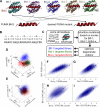

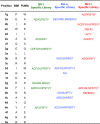

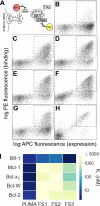
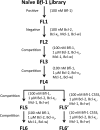





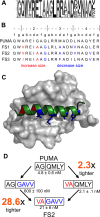

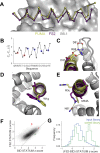














Similar articles
-
Relationship between helix stability and binding affinities: molecular dynamics simulations of Bfl-1/A1-binding pro-apoptotic BH3 peptide helices in explicit solvent.J Biomol Struct Dyn. 2013;31(1):65-77. doi: 10.1080/07391102.2012.691363. Epub 2012 Jul 18. J Biomol Struct Dyn. 2013. PMID: 22803956
-
Crystal Structures of Anti-apoptotic BFL-1 and Its Complex with a Covalent Stapled Peptide Inhibitor.Structure. 2018 Jan 2;26(1):153-160.e4. doi: 10.1016/j.str.2017.11.016. Epub 2017 Dec 21. Structure. 2018. PMID: 29276033 Free PMC article.
-
Binding modes of Bcl-2 homology 3 (BH3) peptides with anti-apoptotic protein A1 and redesign of peptide inhibitors: a computational study.J Biomol Struct Dyn. 2018 Nov;36(15):3967-3977. doi: 10.1080/07391102.2017.1404933. Epub 2017 Nov 24. J Biomol Struct Dyn. 2018. PMID: 29137527
-
PUMA, a critical mediator of cell death--one decade on from its discovery.Cell Mol Biol Lett. 2012 Dec;17(4):646-69. doi: 10.2478/s11658-012-0032-5. Epub 2012 Sep 20. Cell Mol Biol Lett. 2012. PMID: 23001513 Free PMC article. Review.
-
Structural biology of the Bcl-2 family of proteins.Biochim Biophys Acta. 2004 Mar 1;1644(2-3):83-94. doi: 10.1016/j.bbamcr.2003.08.012. Biochim Biophys Acta. 2004. PMID: 14996493 Review.
Cited by
-
Molecular evolution of peptides by yeast surface display technology.Medchemcomm. 2019 Jul 10;10(9):1569-1580. doi: 10.1039/c9md00252a. eCollection 2019 Sep 1. Medchemcomm. 2019. PMID: 31803399 Free PMC article. Review.
-
Splicing modulation sensitizes chronic lymphocytic leukemia cells to venetoclax by remodeling mitochondrial apoptotic dependencies.JCI Insight. 2018 Oct 4;3(19):e121438. doi: 10.1172/jci.insight.121438. JCI Insight. 2018. PMID: 30282833 Free PMC article.
-
Peptides from human BNIP5 and PXT1 and non-native binders of pro-apoptotic BAK can directly activate or inhibit BAK-mediated membrane permeabilization.Structure. 2023 Mar 2;31(3):265-281.e7. doi: 10.1016/j.str.2023.01.001. Epub 2023 Jan 26. Structure. 2023. PMID: 36706751 Free PMC article.
-
Tertiary Structural Motif Sequence Statistics Enable Facile Prediction and Design of Peptides that Bind Anti-apoptotic Bfl-1 and Mcl-1.Structure. 2019 Apr 2;27(4):606-617.e5. doi: 10.1016/j.str.2019.01.008. Epub 2019 Feb 14. Structure. 2019. PMID: 30773399 Free PMC article.
-
Advances in protein structure prediction and design.Nat Rev Mol Cell Biol. 2019 Nov;20(11):681-697. doi: 10.1038/s41580-019-0163-x. Epub 2019 Aug 15. Nat Rev Mol Cell Biol. 2019. PMID: 31417196 Free PMC article. Review.
References
-
- Adams PD, Afonine PV, Bunkóczi G, Chen VB, Davis IW, Echols N, Headd JJ, Hung LW, Kapral GJ, Grosse-Kunstleve RW, McCoy AJ, Moriarty NW, Oeffner R, Read RJ, Richardson DC, Richardson JS, Terwilliger TC, Zwart PH. PHENIX: a comprehensive Python-based system for macromolecular structure solution. Acta Crystallographica Section D Biological Crystallography. 2010;66:213–221. doi: 10.1107/S0907444909052925. - DOI - PMC - PubMed
-
- Barile E, Marconi GD, De SK, Baggio C, Gambini L, Salem AF, Kashyap MK, Castro JE, Kipps TJ, Pellecchia M. hBfl-1/hNOXA interaction studies provide New Insights on the role of Bfl-1 in Cancer cell resistance and for the design of novel anticancer agents. ACS Chemical Biology. 2017;12:444–455. doi: 10.1021/acschembio.6b00962. - DOI - PMC - PubMed
-
- Berger S, Procko E, Margineantu D, Lee EF, Shen BW, Zelter A, Silva D-A, Chawla K, Herold MJ, Garnier J-M, Johnson R, MacCoss MJ, Lessene G, Davis TN, Stayton PS, Stoddard BL, Fairlie WD, Hockenbery DM, Baker D. Computationally designed high specificity inhibitors delineate the roles of BCL2 family proteins in Cancer. eLife. 2016;5:1422–1432. doi: 10.7554/eLife.20352. - DOI - PMC - PubMed
Publication types
MeSH terms
Substances
Grants and funding
LinkOut - more resources
Full Text Sources
Other Literature Sources
Molecular Biology Databases

